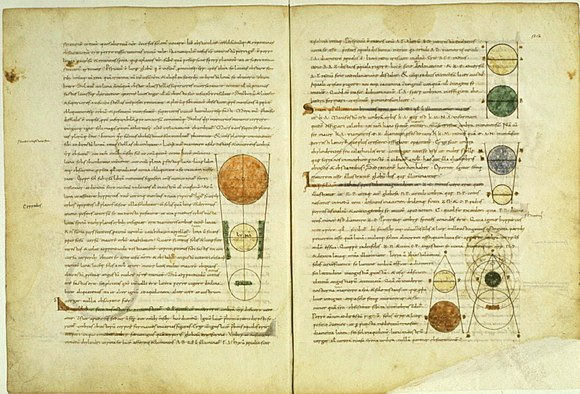From Orpheus and Pythagoras during the medieval Proto-Renaissance and Dante Allegieri to the heterodox Islamic cult
For Dante there are three pairs of numbers having a symbolic value par excellence: 3 and 9, 7 and 22, 515 and 666. For the first two we have no problems in deciphering – it is clear that the general scheme of the poem is tertiary, but there are other more deep considerations. Let us remember that in Vita Nuova Beatrice’s number is 9. This number 9 immediately reminds us of the triple trinity – the nine ranks in the hierarchy of angels, indicating the number of heavens and circles of hell, creating opposite symmetry between heaven and hell.
For the number 7, which we find predominantly in the division of purgatory, all traditions define it as a sacred number; by listing some of its most characteristic manifestations – the seven planets and the whole set of similar corresponding concepts [e.g. the seven liberal arts – the seven virgins accompanying philosophy are the embodiment of the seven liberal arts studied in higher schools as propaedeutic disciplines; they in turn were divided into two groups: three of them, the sciences of words (grammar, rhetoric and dialectics), formed the so-called “trivium”, and the other four, the sciences of things (arithmetic, music, geometry and astronomy) , formed the so-called “quadrivium”]; the creation of the world lasted 7 days; the week has 7 days; human life is divided into 7 periods; there are 7 notes in the music; the wonders of the world are 7; the spectrum consists of 7 colors; “Our Father” is divided into 7 parts; the apostles ordained 7 deacons; mortal sins are 7; Enoch, who ascended alive to heaven, was the 7th forefather after Adam: The Savior Jesus Christ spoke 7 times on the cross, where he spent 7 hours, appearing 7 times after His death, and after 7 times for 7 days He came. St. Spirit (at Pentecost). Prof. Rodolfo Benini gives us very interesting elements about the role of numerical symbolism in Dante’s work (cf. Rodolfo Benini, “Per la restituzione della Cantica dell’Inferno alla sua forma primitive,- Nuovo Patto, septembre-novembre 1921, pp. 506-532).
“For Orpheus, the number 4 (tetrachord) is the emblem of the sanctuary in Delphi and Egypt and means the voice of the sirens (death). The number 5 is the Orpheus pentagram – a sign of Christmas and with his pentatonic Orpheus overcame the sirens to save the agronauts from drowning. The number 6 is the hexameter – discovered by Orpheus – and used in clairvoyance. (All Pythias prophesy in verse by hexameter – this is the poetry of the clairvoyants).
“In the sixth degree, stop!” Means that this is the human capacity. The number 7 is God. “Everything is the number seven!” Orpheus wrote, and Pythagoras repeated it. Seven notes sung from one throat at the same moment – this is God. This is the cosmic silence – harmony of the divine worlds. ”- Nikola Gigov, Orpheus and the Alphabet, HELIOPOL, 2006, p. 27.
The number 22 is related to 7 by 22/7 or between the circumference and the diameter in a way that the two numbers together give us the circle, and the latter is the most perfect figure according to Dante, as in the time of the Pythagoreans (all divisions of each of the three worlds have a round shape); moreover, 22 combines the symbols of two of the “elementary motions” of Aristotle’s physics: the local motion represented by 2 and that of the alteration represented by 20, as Dante himself explains in Convito (the third “elementary motion” of the intersection is represented by the number 1000, and the sum of the three symbolic numbers is 1022, which is the number of “Egyptian sages”, according to Dante’s testimony, who took the number of permanent stars).
On the other hand, the number 22 is a doubling of the number 11, which is extremely important. In Dante’s Hell, most of the full scenes or episodes into which the various songs are subdivided contain exactly eleven or twenty-two stanzas (only a few contain ten); there are several preludes and endings of seven stanzas each. But there is also the number 33 in the poem, which coincides with the number of songs into which each of the three parts of the work is divided.
Hell alone is of 34 songs, but the first is rather a general introduction to the whole work, which fills the number 100 for the whole work. The various multiplications and increments of the number 11 have a specific symbolic value. In fact, eleven plays a significant role in the symbolism of diverse and societies of initiates; his products also: 22 are the letters in the Hebrew alphabet and hence in Kabbalah; 33 are the years of Christ’s earthly life, which later represent the symbolic age of Rosicrucian Freemasonry, and also 33 are the degrees of Scottish Freemasonry. The number 515 (5 + 1 + 5) itself is again 11. For 666 its main meaning is the number of the beast from the New Testament Apocalypse; hence it denotes the Antichrist.
The number 66 is in Arabic the numerical value of the name of Allah, and 99 is the number of the main divine attributes according to Islamic tradition.
In the collections of National Museum of History – Sofia there is a curious object related to the Islamic cult in Bulgaria professed by the heterodox population (Bektashi and Alevi, ie Kazalbashi), interesting as a material expression of beliefs with a very ancient, though already forgotten, root – ” The Bektash Stone ”, which served as an amulet.
It is a 12-pointed star made of black stone with engraved symbols and inscriptions on both sides – on the obverse almost in the center of a field bordered by a double circle, a dervish hat (tac) is depicted, above which is written the name محمد (Mohammed). both sides – strongly stylized and divided into two syllables the name of his cousin and son-in-law على (Ali). The rest of the space is completely occupied by a circular inscription engraved on the periphery الا على لا سيف الاذوالفقار (There is no other [hero] except Ali, no other sword except Zulfikar). On the back, two double circles form central and peripheral circular fields. In the center is engraved a hexagram symbol, a 6-pointed star composed of two intertwined triangles and a dot in the middle, a trace of the compass used to delineate the circles. In the peripheral field above the hexagram – an inscription, which can be conditionally read as the usual magic formula for amulets ماشالله (Mashallah).
This pendant was worn only by members of the Bektashiya Muslim Order and is its symbol. We see him attached to a belt or hung around the neck of Bektashi as an emblematic element of his clothing (see Fig. 2; cf. Tsveta Raichevska, Amulet associated with the Bektashi Order in Bulgaria, Bulletin of the National History Museum – Sofia, Volume XVII, 2006, pp. 41-44).
Of particular interest to us is the sacred number-symbol – 12. The names Mohammed – Ali are written as equivalent on the medallion, which defines it primarily as Shiite, as adherents of Shiism, one of the two fundamental currents in Islam, worship Ali, a cousin. and son-in-law of Muhammad, husband of his daughter Fatima, even more than the Prophet himself.
This inadmissible deification of Ali for orthodox Sunni Muslims is rooted in the aforementioned fundamental division in Sunni and Shiite Islam. The periphery of the medallion is cut out like a 12-pointed star, which again refers us to Shiism. The number 12 is sacred to Shiite Muslims as it symbolizes their Twelve Imams. After 874-878, when the 12th imam, the child Mohammed al-Qa’im, disappeared without a trace, the Shiites began to expect the appearance of the so-called Mahdi, i.e. “The hidden imam”. The long waiting period is filled with bloody wars between Shiites and orthodox Sunni Muslims.
Ali himself, a victim of his wounds in 661 when he was slaughtered outside the mosque in Kufa, Iraq, fell victim to this fundamental enmity. His sons had a similar fate. It is obvious that the twelve peaks of the pendant symbolize the 12 Shiite imams.
From a chronological point of view, Dante’s poem is set in the days of the great (holy) week before Easter, ie at this time of the liturgical year, which coincides with the vernal equinox; at this time the Cathars also dedicated their innovations, a time for initiations.
At the Rosicrucians, the celebration of the Last Supper took place on Holy Thursday, and the work was resumed only at about 3 o’clock in the afternoon on Good Friday – the day and hour of Christ’s death. In 1300, this week coincided with the full moon. The period between 1300 and 1314 was full of events for the destruction of the Order of the Knights Templar. Dante speaks of these “new events” by modifying the chronological and architectural plan of his Hell after its first edition.
In 1307, Philip the Good, in agreement with Pope Clement V, arrested the Grand Master and the chief dignitaries of the Knights Templar (72 in number, also a symbolic number); in 1308 Henry of Luxembourg was elected emperor; in 1312 the Knights Templar were officially dissolved; in 1313 imp. Henry VII died mysteriously, no doubt poisoned; in 1314 was the public execution of the Templars, and the case against them lasted 7 years; that same year, King Philip the Good of France and Pope Clement V died in turn.













Comments are closed.